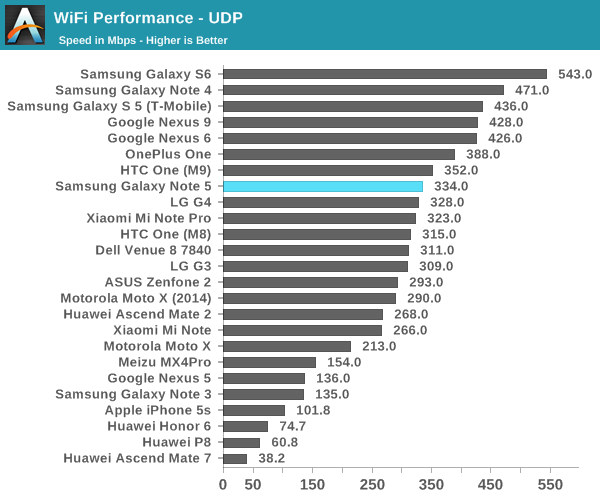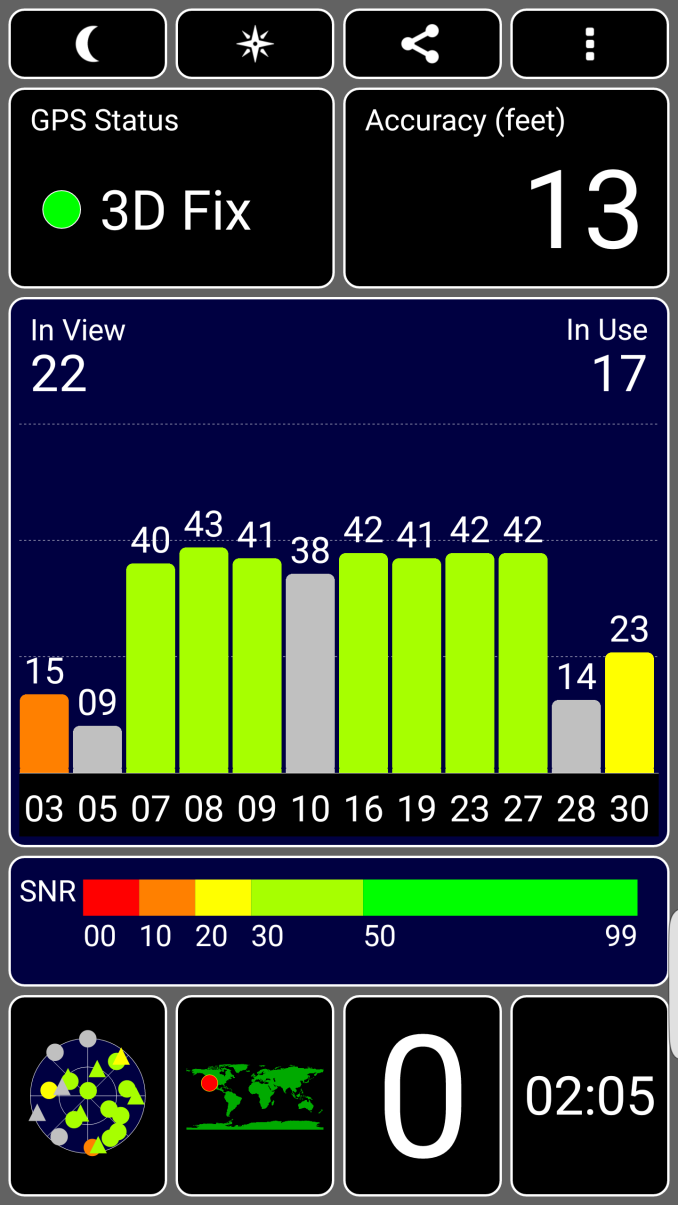The Samsung Galaxy Note5 and Galaxy S6 edge+ Review
by Joshua Ho on October 2, 2015 8:00 AM ESTVideo Performance
Now that we’ve taken a look at still image performance, we can look at video performance. For the most part these results should be similar to still image performance, but we’re looking at encoder efficiency, good sound recording, and effective stabilization. The Galaxy Note5 and Galaxy S6 edge+ both have OIS in order to improve stability in video recording, and for the most part the feature set of both is similar to the Galaxy S6 when it comes to video.
Galaxy Note5
Galaxy S6
Galaxy Note5
iPhone 6
For 1080p30, Samsung has elected to use 17Mbps High Profile H.264, along with a 256 Kbps stereo audio channel encoded with AAC. If this sounds familiar, it's because this is shared with the Galaxy S6. Quality is indistinguishable. Unfortunately, it seems the same sort of jerky OIS reset effect is still present although it isn't too obvious in these videos.
Galaxy S6
iPhone 6
It probably goes without saying, but once again the Galaxy Note5 shares the same video encode settings with the Galaxy S6, with 28 Mbps High Profile H.264 encoding for 1080p60 video. In these samples you can more clearly see the issues that come with OIS in video, which is that there are instances of jerky video movement when it should be relatively smooth, even if it's shaky. The only real difference between the Galaxy S6 and Note5/S6 edge+ is that the Note5 removes a bit of the yellow tinge/saturation boost that we see in the Galaxy S6. There's otherwise relatively little to comment on here.
Once again, not much is different when comparing the Galaxy Note5 and Galaxy S6 edge+ to the Galaxy S6 other than saturation differences in some cases. The same encoder settings are also used for 48 Mbps HP H.264 with 256 Kbps AAC stereo audio.
Galaxy Note5
Galaxy S6
Galaxy Note5
iPhone 6
If you're able to read the trend, you can probably guess that the Galaxy Note5 and S6 edge+ are going to share the same encode profiles as the Galaxy S6, which is 48Mbps HP H.264. Once again, quality is effectively identical here and the changes are slim to none. This unfortunately means that the iPhone 6 still leads here as the quality of the slow motion video on the Galaxy Note5 and Galaxy S6 line weren't much good to begin with.
WiFi Performance
For the most part, it probably goes without saying that one of the cornerstones of a smartphone or phablet is mobile data. After all, without mobile data you’re effectively limited by whatever WiFi hotspot you can find, which is often limited in range. Comparatively speaking, mobile data is generally more versatile. However, in the case of most mobile devices WiFi is often used at home in order to utilize a normally lower-latency connection with generally higher throughput. Given the reality of data caps, WiFi is also often needed for things like app updates, video streaming, and possibly music streaming. As a result, poor WiFi can sink a phone. In order to try and get a basic measure of performance, we look at peak UDP bandwidth using iPerf. In the case of the Galaxy Note 5, Samsung has upgraded the WiFi chipset from the BCM4358 used in the Galaxy S6 to Broadcom’s BCM4359. This is supposed to allow connections to 2.4 and 5 GHz WiFi simultaneously, but in practice it doesn’t really look like it’s used outside of potentially faster scanning.

Interestingly, I was unable to get the download speeds that I was expecting from a 2x2 802.11ac WiFi solution despite using 5 GHz. It's possible that this is due to interference as I can't isolate the system from other WiFi hotspots in the area, but in my experience I never had any real issues with WiFi that I could notice. Reception doesn't seem to be any better or worse than other devices I've tried in recent memory.
GNSS Performance
GNSS is often critical to a mobile device these days, as a number of applications rely on highly accurate location in order to work properly. Probably the most obvious case here is going to be GPS navigation, but things like lost/stolen device location, geofencing, location-based check-ins, and other applications are all generally quite reliant on accurate location that only GNSS systems can provide. In the case of the Galaxy Note5 and Galaxy S6 edge+, we see that the GNSS module is shared with the Galaxy S6 for the Shannon modem variants as a BCM4773 GNSS location hub is present within the system.
In practice, I didn’t find much wrong with this solution. Time to first lock without any assistance data took about 30 seconds, and at the 46 second mark the maximum possible accuracy was achieved. With assistance data, a position fix was reported within 5 seconds of launching the GPS Test app. Overall, I doubt anyone will face any real problems dealing with GPS/GNSS location on these devices.











225 Comments
View All Comments
theduckofdeath - Thursday, October 8, 2015 - link
There are issues for desktop sized high resolution displays. The biggest one is volume and production cost. Just look at what you have to pay for an LG OLED telly compared to a nano LED telly. Like Kamus said, look up what professional display calibration companies says about SAMOLED. It's not "on par", it's in a league of its own.thedons1983 - Sunday, October 18, 2015 - link
You are an idiot. The reason that top end monitor manufacturers don't use OLED, or AMOLED, is because they can't afford to. Eventually they will replace LCD, when they can afford to. LCD is crap technology and outdated, and will eventually be entirely replaced, when the costs make sense. Samsung can produce AMOLED screens, because they actually build them!! Apple builds nothing. At all. They buy their tech from others whom have the know how. Therefore, they pay through the nose for it, and aren't ever even offered the superior tech, because, why would you bother?! You'd maybe understand these issues, we're you not such an utter moron.sany - Monday, October 5, 2015 - link
HiI've been wondering, having the best chip to process still photos and good software - why still slow motion FPS rate is still kept too low compared to the slow motion fps for iPhone. Is this a limitation with hardware or can be fixed through an software update?
thedons1983 - Sunday, October 18, 2015 - link
Dude, seriously, smartphones take terrible pictures. The camera tech they employ is light years behind that used in actual cameras. Any photographer using their smartphone as there primary photographic device, is an utter moron!! Probably an unsuccessful one too!!Peichen - Monday, October 5, 2015 - link
As an iPhone user that also played with Samsung and LG flagships extensively, I feel Samsung Galaxy S and Note are the only phone that can be mentioned in the same sentence as iPhone. No other Android phones come close to S and Note's Apple-like hardware and refinements. Android + TouchWiz still lags and not as stable as iOS but where Samsung did their homework it is at Apple's level. I hope the upcoming V10 and Z5 Premium is as well made and tweaked as Note 5.thedons1983 - Sunday, October 18, 2015 - link
Your opinion is entirely meaningless, as you haven't used any flagship Android devices, other than Samsung. Sony make great phones, as do HTC, and Google and Motorola, and Huawei... Need I go on?? You might know this, if you weren't so entirely blinkered and pathetic.jrich7 - Monday, October 5, 2015 - link
Just picked up a Note 5 today, ugraded from the Nexus 6 and wow its way faster ! The batter drains a little faster but the fast charge feels just sweet and that see coming from another fast charge device. The screen is beautiful and the spen is going to come in handy. The only thing I really like better in the Nexus 6 was the two front facing speakers. I thought I would not like TouchWiz because I heard it's slow compared stock androld but the hardware on the phone makes up for it like 10 fold ! I'm very happy with this device :)coolhardware - Tuesday, October 6, 2015 - link
The Nexus 6 had splendid speakers! That was my biggest complaint switching from it to a smaller Galaxy S6.For another set of nice stereo phone speakers, check out the Moto X Pure Edition. My wife has one and the speakers sound good, better than any phone from Samsung or Apple IMHO. :-)
Speaking of Apple, I am excited to hear the speakers on the new iPad Pro. I'm *hoping* they really advance the tablet speaker situation to a new level!
thedons1983 - Sunday, October 18, 2015 - link
Thank you! The opinion of someone who has actually bought the device in question, is always going to be more legitimate, than the reams of idiots who have only ever used an iPhone. Good work, for bothering to add your two cents, it is appreciated.Thounee - Monday, October 12, 2015 - link
Hey staff @ Anand. I tried to look for any review of Xperia's (Z3, Z3+/Z4 or new Z5's) but came up empty. Since the sensors and image/video quality is considered as best by some benchmarks in the industry (look at dxomark), it would be nice to see your take on the latest versions.